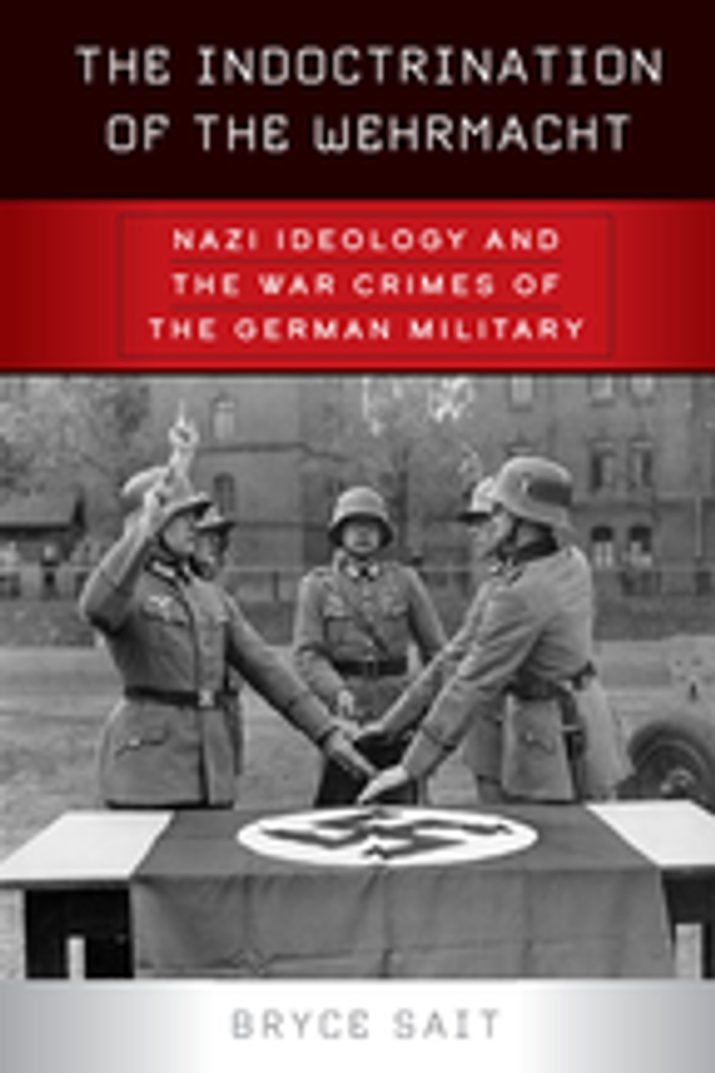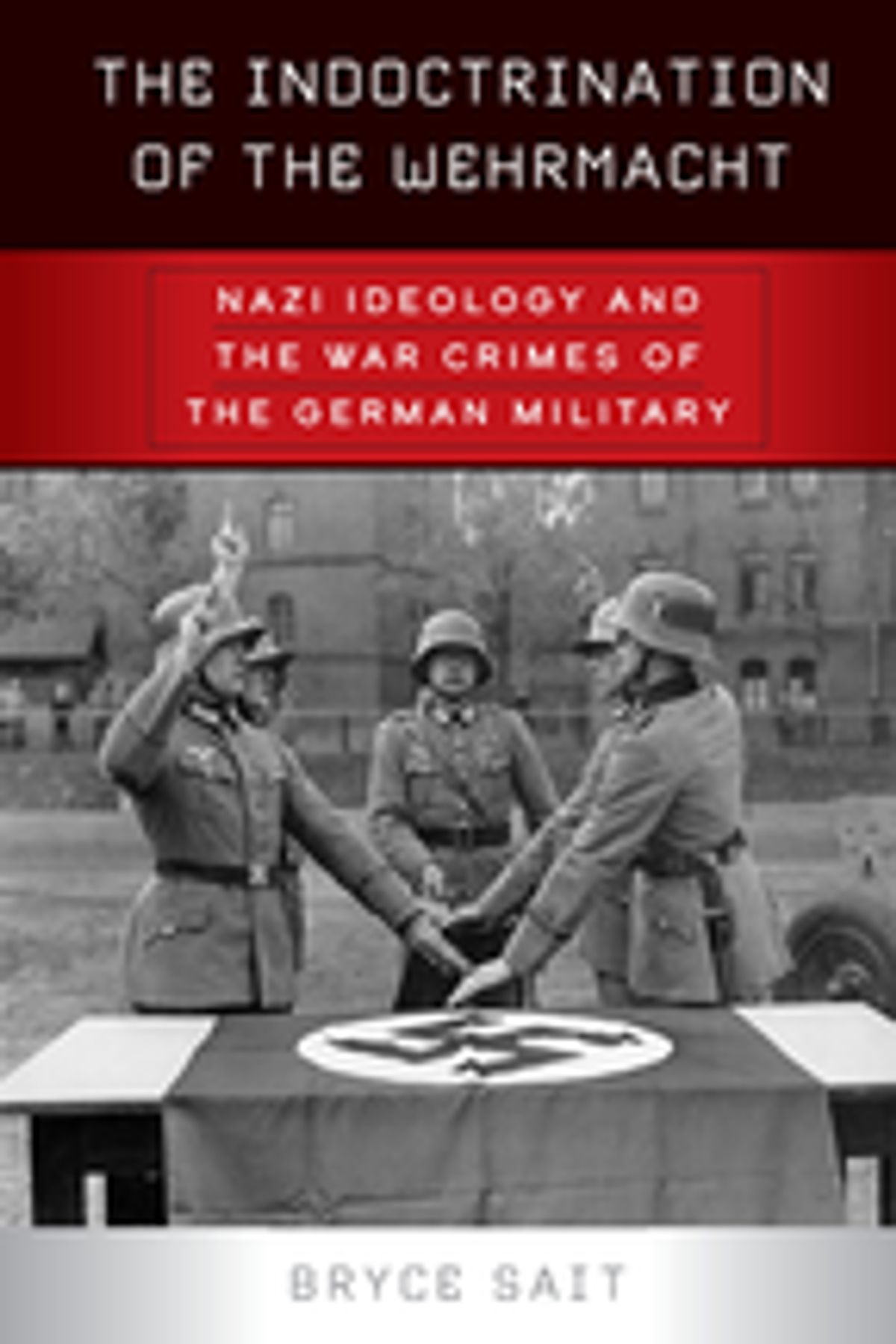
The Indoctrination of the Wehrmacht: Nazi Ideology and the War Crimes of the German Military by Bryce Sait

Over the last several decades, scholarship on the Wehrmacht—the German military during the Third Reich—has overturned the longstanding myth that its officers and men avoided involvement in the crimes of the Nazi regime. It is now well established that the Wehrmacht committed atrocities on a wide scale, targeting Jews, suspected resisters, and ethnic groups classified as inferior, particularly in its campaigns in Eastern Europe. To explain the army’s behavior, historians such as Omer Bartov and Walter Manoschek have emphasized the influence of Nazi ideology within its ranks.[1] Although it is generally recognized that the army adopted elements of the Nazi value system, however, there has been little investigation of precisely how this process occurred and how it shaped the army’s wartime conduct.
In The Indoctrination of the Wehrmacht, Bryce Sait sets out to more firmly establish the connection between the army’s program of ideological education and its criminal actions on the battlefield. To accomplish this, he reaches back into the early days of the Nazi regime to examine the nature of indoctrination within the Wehrmacht and how the conditioning soldiers received helped to create the context for their involvement in atrocities. Sait argues that schooling in Nazi values became a central pillar of Wehrmacht training by the mid-1930s, earlier than many scholars have assumed. Further, he demonstrates that the brutality shown toward ideological enemies during the war represented a natural outgrowth of its internal discourse. Thus, he emphasizes the importance of ideology in molding the perceptions and actions of Wehrmacht personnel, although he does not dismiss the role of other factors.
To investigate the Wehrmacht’s indoctrination program, Sait relies on regulations, orders, and internal correspondence from its leadership; pamphlets and other training materials; and—primarily in the last chapter—letters from the soldiers themselves. The book is organized in roughly chronological fashion. Early chapters discuss the military’s relationship with the Nazi regime and the steps it took to integrate ideology into its training. Later chapters examine how ideology influenced the Wehrmacht’s conduct in Poland, Serbia, and the Eastern Front, how it compared to other Nazi organizations, and to what extent Christianity served as a potential source of competition for hearts and minds. Taken as a whole, the book makes a valuable contribution to the historiography by shedding much-needed light on the process by which the Wehrmacht became “Hitler’s army.” Although many of his conclusions reinforce existing scholarship rather than offer new directions, Sait convincingly shows that the Wehrmacht’s engagement in atrocities on the Eastern Front was a logical extension of its longstanding ideological training program. Soldiers and officers were not striking out in a new direction but faithfully fulfilling the vision they had been taught within the Wehrmacht since the early 1930s. The book is not without its limitations, however. These include an over-reliance on secondary sources, a top-down perspective that often overlooks the views of the rank-and-file, and the problem of disentangling the impact of the Wehrmacht’s indoctrination program from other elements that affected its battlefield conduct.
The nature and effectiveness of indoctrination within the Wehrmacht is the first major theme of Sait’s work. In contrast to other authors who have emphasized the importance of indoctrination young men experienced even before entering the military, or who believe that it was only during the war with the Soviet Union that the Wehrmacht truly embraced the Nazi worldview, Sait convincingly argues that the military developed a comprehensive program of ideological education within the first few years of Hitler’s rise to power that greatly influenced its modus operandi. Sait opens his analysis by examining the nature of the relationship between the military and the Nazi regime after Hitler’s appointment as chancellor. Sait points to the officer corps’ longstanding tradition of antisemitism, anti-communism, right-wing authoritarian leanings, hatred of the Versailles Treaty, and the influence of the strenuously pro-Nazi defense minister General Werner von Blomberg to explain why the army quickly discarded its “apolitical” mantle. At Blomberg’s direction, the Wehrmacht enthusiastically transmitted Nazi values throughout its ranks through compulsory classroom instruction on ideological topics, a steady stream of newspapers and booklets, and workshops and conferences for officers. Sait’s sources indicate that the massive influx of new recruits in 1935 caused concerns among army leaders, who found that many had an unsatisfactory understanding of Nazi principles. Undeterred, they continued to make ideological education a central component of training. During the war itself, Sait contends, the Wehrmacht’s propaganda materials became more and more indistinguishable from the messaging embraced by the SS.
Sait’s argument regarding the effectiveness of ideological indoctrination in the Wehrmacht relies in part on a compelling theoretical framework based on studies in the fields of psychology and sociology that seek to understand how tightly-run organizations disseminate their preferred worldview. Sait discusses such factors as the control of information, de-individualization, and the dehumanization of the enemy, all within a stressful, authoritarian environment. In the heat of battle, Sait argues, soldiers naturally fall back on the ideological reference points provided by their institution to guide their behavior. To explain how ideology was translated into practice in the Wehrmacht, Sait suggests that it became embedded within the army’s tradition of Auftragstaktik (“mission-type tactics”), which encouraged personnel to take a high degree of initiative as they strove to realize their commanders’ intentions. Through this mechanism, Sait believes, ambiguous orders were often interpreted in an ideological light by the lower ranks. Besides describing the contents of ideological training and analyzing how it functioned on a theoretical level, Sait attempts to place the Wehrmacht’s indoctrination program within the larger context of the Third Reich’s institutions and value systems. In Chapter Five, he details how Germany’s young men were subjected to ideological propaganda as they passed through the Hitler Youth and the Reich Labour Service even before they entered the Wehrmacht. He assesses the successes and limitations of this messaging, arguing that it created a foundation upon which the Wehrmacht built. In Chapter Six, Sait probes the limits of ideology in the military by considering the competing influence of Christianity. He acknowledges the army’s centuries-old Christian tradition, as well as the fact that the chaplaincy continued to exist despite Nazi plans to the contrary. He concludes, however, that Christianity never emerged as a true ideological threat, largely due to tight restrictions surrounding the chaplains’ work.
Concerning the first major theme of the book—the military’s indoctrination program—Sait is more successful than not in demonstrating that the Wehrmacht quickly embraced the Nazi movement and thoroughly incorporated Nazi ideas into its institutional culture. For those versed in Wehrmacht historiography, however, this argument mostly retreads familiar ground. Here and there, Sait turns up previously-unknown archival sources, but the narrative relies heavily on classic secondary works by such authors as Gordon Craig and Klaus Jürgen Müller. More problematic is the almost total absence of primary sources presenting the views of ordinary soldiers themselves. Without these, it is difficult to assess the extent to which the men who would be fighting the Reich’s wars truly absorbed the ideas they were being fed. A clear sense of the amount of time spent on ideological activities—as opposed to a recruit’s many other training duties—would be particularly beneficial, but is likewise missing from the analysis. Finally, Sait’s argument tends to rely on the assumption that top-down regulations were scrupulously followed and uniformly applied, an assumption that did not always hold true in such a massive and complex organization as the Wehrmacht, least of all during wartime. The chapter on religion is emblematic of some of these problems. Sait focuses primarily on chaplains—a relatively tiny group—while overlooking the wide spectrum of religious belief among the millions of soldiers who adhered to the Christian faith. Within the chaplaincy, he spends much time analyzing OKW’s regulations but little on the experiences of the chaplains themselves. Sait also relies almost exclusively on the analysis of Doris Bergen and largely ignores the Catholic chaplaincy, as well as Protestant chaplains who did not adhere to the German Christian movement. Nevertheless, Sait is right to conclude that Christianity, while it existed in tension with Nazi ideology in the Wehrmacht, never became a force for widespread resistance.
The book’s second theme, addressed in chapters Four and Seven, concerns the extent to which ideology influenced the Wehrmacht’s conduct on the field. Following in the footsteps of Alexander Rossino, Ben Shepherd, and others, Sait makes a convincing case that ideology played a major role in Wehrmacht atrocities.[2] In Poland, the army showed little mercy toward a civilian population many troops considered racially inferior and worked closely with the SS to round up Jews. In Serbia, personnel eagerly targeted racial and political enemies even in the face of ambiguous orders. In the USSR, the High Command explicitly tied strategic and ideological goals from the outset and soldiers became complicit in widespread criminal violence against Jews, POWs, and suspected partisans. As he discusses the Soviet campaign, Sait provides examples from soldiers’ letters reflecting agreement with the Nazi program—a welcome addition to his source base—and offers an excellent discussion of the military censorship system. Like the observation that the Wehrmacht incorporated ideology into its training, the conclusion that ideology played a role in its criminal conduct is not particularly new. Since the late 1970s, historians have catalogued the Wehrmacht’s crimes and uncovered evidence that its personnel were deeply influenced by ideology. Further, Sait encounters two complications that make it difficult to precisely assess the nature of this influence. The first is the question of whether the army’s training program was more or less decisive in shaping soldiers’ worldviews than the many other sources of Nazi propaganda (not to mention alternative value systems) to which Germany’s young men were exposed as they grew up in the Third Reich. Sait emphasizes the importance of the former, but these various strands of influence ultimately prove difficult to untangle with the sources at hand. The second complication concerns the relative significance of Nazi ideology as a catalyst for battlefield atrocities. As Sait acknowledges, several other factors played a role, including the army’s historic predilection for extreme violence against civilians and centuries-old antisemitic tradition. Further research is needed to assess whether ideology was truly the dominant influence on the army’s behavior.
Despite its limitations, this is an important book, one that provides a clear and compelling narrative for readers interested in how the Wehrmacht evolved into a willing tool of the Führer. While it relies heavily on the findings of previous research, Sait’s approach effectively situates these findings within the context of the Wehrmacht’s institutional culture dating back to the beginnings of the Nazi regime. He convincingly demonstrates that the brutality it exhibited on the field did not represent a sudden new direction but a logical extension of the rhetoric it had aggressively propagated within its own ranks for nearly a decade.
David Harrisville received his PhD from the University of Wisconsin-Madison in 2017 and subsequently served as Visiting Assistant Professor of History at Furman University. His book manuscript, which analyzes moral discourse in the Wehrmacht and the origins of the myth of its “clean hands,” is forthcoming from Cornell University Press. He currently works as an Information Technology Learning Specialist at Legal Services Corporation in Washington, DC.
The Indoctrination of the Wehrmacht: Nazi Ideology and the War Crimes of the German Military
By Bryce Sait
Publisher: Berghahn Books
Hardcover / 204 pages / 2019
ISBN: 978-1-78920-149-9
References:
[1] Omer Bartov, Hitler’s Army: Soldiers, Nazis, and War in the Third Reich (NY: Oxford University Press, 1991); Walter Manoschek, ed., Die Wehrmacht Im Rassenkrieg. Der Vernichtungskrieg Hinter Der Front (Vienna: Picus, 1996).
[2] See Alexander Rossino, Hitler Strikes Poland: Blitzkrieg, Ideology, and Atrocity (Lawrence, KS: University Press of Kansas, 2003); Ben Shepherd, Terror in the Balkans: German Armies and Partisan Warfare (Cambridge, MA: Harvard University Press, 2012).




